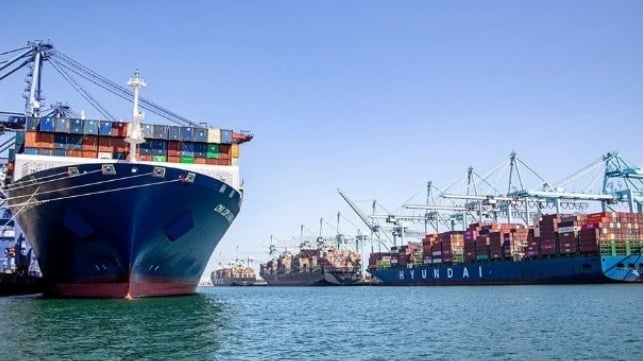Los Angeles Reaches 10.9M TEU for Year, Projecting Continuing Volumes

The Port of Los Angeles continued its record-breaking run closing out its fiscal year with volumes maintaining the pace experienced throughout the year. The port expects that the pace will continue through the remainder of 2021 continuing to challenge all parts of the supply chain to keep up with the demand coming from strong consumer spending.
Over the past 12 months, the Port of Los Angeles eclipsed eight monthly records, had its two highest-performing quarters, and four individual months that topped records in the port’s 114-year history. The busiest June ever at the port also brought the fiscal year to a record of just under 10.9 million TEU. The Port of Los Angeles was the first Western Hemisphere port to surpass the 10 million milestone.
“Key economic indicators all suggest that U.S. consumer spending will remain strong through the remainder of 2021,” said Port of Los Angeles Executive Director Gene Seroka. “Fall fashion, back-to-school items, and Halloween goods are arriving on our docks, and some retailers are shipping year-end holiday products early. All signs point to a robust second half of the year.”
The port is also introducing a new forecasting tool that uses algorithms and data to present the outlook for up to six months. The new tool projects that an additional 5.1 million TEU will pass through the port in the second half of calendar 2021 for a total of 10.5 million TEU for the year.
Seroka also highlighted that the entire supply chain process in the U.S. remains under pressure, but that the port continues to make progress to handle the flow of containers. He said productivity on berth has increased 50 percent with increased work shifts for the union employees. The port has reduced the number of vessels going into the anchorage on arrival to half with an average wait time of five days. Currently, there are 10 vessels in the anchorage with an additional six expected to arrive at the port before the end of the week. Dwell times on berth, rail times, and street dwell times however remain near their peaks.
The disruptions in southern China and specifically the port of Yantian that began in May and extended into June are also having a ripple effect on the Port of Los Angeles, where a third of all vessels originate from those Chinese ports. Time at anchor in the San Pedro Bay increased as more vessels have been able to load and depart China and Seroka expects that the port will continue to see increased volumes from southern China in the coming weeks.
While import volumes continue at pace without a letup, the Port of Los Angeles saw its lowest export volumes in June since 2005. Export volumes dropped to under 100,000 TEU with empties leaving the port at a rate of nearly five to one. Seroka said that some southern California agricultural exporters are especially scrambling to find containers.
Seroka continues to call for actions to address the trade imbalance. Answering a question, he also said that in response to President Joe Biden’s order the Federal Maritime Commission should absolutely be investigating any unfair competition allegations and enforce the regulations. He acknowledged that issues impacting the U.S. supply chain are complex, but he believes President Biden’s order and the FMC are actively pursuing solutions to improve the supply chain and throughput in ports.
